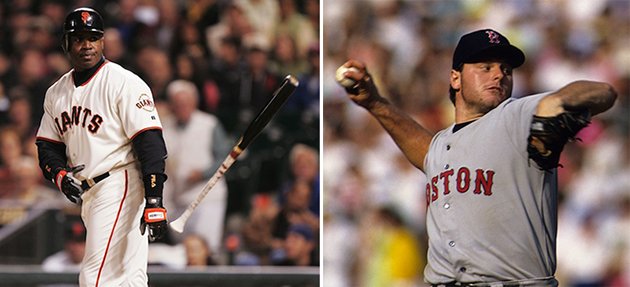 Now that this year’s Hall of Fame voting results have been released, much is being made of the fact that baseball’s two greatest PED pariahs, Barry Bonds and Roger Clemens, went up in the voting from 36.8/37.5% to 44.3/45.2% in their fourth year on the ballot. That’s progress, but since you need to be listed on 75% of the ballots to get in, they still have a ways to go.
Now that this year’s Hall of Fame voting results have been released, much is being made of the fact that baseball’s two greatest PED pariahs, Barry Bonds and Roger Clemens, went up in the voting from 36.8/37.5% to 44.3/45.2% in their fourth year on the ballot. That’s progress, but since you need to be listed on 75% of the ballots to get in, they still have a ways to go.
Perhaps farther than you might think. A look at the tally shows that their actual vote barely changed. In fact, fewer people voted for Bonds and Clemens this year, 195 vs. 202 for Bonds and 199 vs. 206 for Clemens. Their percentage went up because overall only 440 people voted this year, down from 549 in 2015.
Hall of Fame ballots are cast by people who have been members of the Baseball Writers Association of America for at least 10 years. Originally, members were all newspaper writers, but in recent years, reporters from other media have been included.
Once in, most people kept their membership, and voting privileges, as long as possible, whether or not they were still working reporters. The number of ballots would change from year to year, but usually only by a few.
Then, for the 2016 election, the Hall of Fame took ballot privileges away from BBWAA members who hadn’t covered the sport in the previous 10 years. As a result, this year there were 109 fewer voters than there were in 2015.
It’s a safe assumption that most of the reduction was due to the rule change, which affected mostly older members. There’s a further assumption that those older writers were the voters most offended by allegations of PED use, and were for the most part not listing Clemens and Bonds, who are clearly HoF-caliber players if you don’t take PED use into consideration, on their ballots.
But if you assume that few, if any, of those 109 ballots listed Clemens and Bonds, what you’re saying is that since their raw vote totals didn’t change much, there was little, if any, increase in support for Clemens and Bonds among the remaining voters. That would not bode well for their future chances of enshrinement, even after the forced extinction of the dinosaur voters.
What would be more hopeful is that some of the 109 voted for Clemens/Bonds, and those lost votes were replaced by an equal number who changed their mind and added the pair to their ballots. From Clemens’ and Bonds’ point of view, the more votes that fall into this category, the better.
Since baseball doesn’t release individual writer’s ballots, there’s no way to know for sure what the actual situation is. Some BBWAA members have chosen to make their ballots public on the BBWAA web site. On the 2015 list, 94 of 231 voted for Bonds and 93 voted for Clemens, about 40%. On the 2016 list, 74 of 135 voted for Clemens and Bonds, about 55%.
There were 113 names on both lists. Of those, 56 voted for Bonds/Clemens in 2015, and 63 voted for the pair in 2016. So to the extent that these voters represent the whole, it appears that Bonds and Clemens did make small gains among the remaining voting population.
Clearly the change has helped Bonds and Clemens, but not enough. At least they can be almost certain that that their support among the remaining voters didn’t decrease any.
Should Bonds and Clemens be in the Hall? Of course. I’d explain, but Joe Poznanski has already done it for me. To summarize, “Keeping two of the greatest players who ever lived out of the Hall of Fame will not change that history. In many ways, it is insulting to think that it will. Baseball is not what the dreamers and poets want to make it. Baseball is joyous, flawed, generous, cruel, honorable, crooked, respectable, selfish and, most of all, real. Bonds and Clemens cheated. Well, baseball has long celebrated cheaters. The Hall of Fame is full of them. I vote for Bonds and Clemens because they were overwhelming baseball players, the best I ever saw.”
